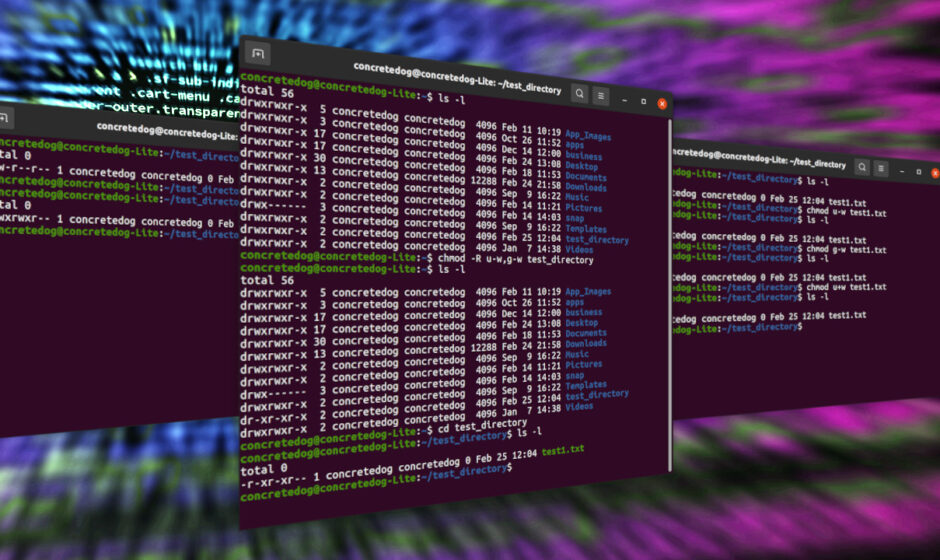Involving Linux as your working framework allows you to all the while effectively give admittance to numerous users. Nonetheless, that entrance additionally presents potential security gambles. Understanding the assortment and kinds of Linux document permissions for users and groups will guarantee that your framework is optimally secure.
This guide talks about the fundamentals of Linux record permissions, and it likewise clarifies how for achieve a few urgent undertakings including
How would I change directory permissions in Linux?
To change directory permissions in Linux, utilize the accompanying:
- chmod +rwx filename to add permissions
- chmod – rwx directoryname to remove permissions.
- chmod +x filename to allow executable permissions.
- chmod – wx filename to take out compose and executable permissions.
Note that “r” is for perused, “w” is for compose, and “x” is for execute.
This main changes the permissions for the proprietor of the document.
What are the three authorization groups?
There are three choices for authorization groups accessible to you in Linux. These are
-
owners: these permissions will just apply to owners and won’t influence different groups.
-
groups: you can dole out a gathering of users explicit permissions, which will just effect users inside the gathering.
-
all users: these permissions will apply to all users, and accordingly, they present the best security risk and ought to be doled out with alert.
What are the three sorts of document permissions in Linux?
There are three sorts of record permissions in Linux:
- Peruse (r): Allows a client or gathering to see a document.
- Compose (w): Allows the client to compose or change a document or directory.
- Execute (x): A client or grup with execute permissions can execute a document or view a directory.
More ways of overseeing permissions
Here is a more complete list of ways you can oversee record permissions, groups, and ownership past the fundamental orders listed at the highest point of this aide.
The most effective method to Change Directory Permissions in Linux for the Gathering Owners and Others
The order for changing directory permissions for bunch owners is comparative, yet add a “g” for gathering or “o” for users:
-
chmod g+w filename
-
chmod g-wx filename
-
chmod o+w filename
-
chmod o-rwx foldername
To change directory permissions for everybody, use “u” for users, “g” for bunch, “o” for other people, and “ugo” or “a” (for all).
-
chmod ugo+rwx foldername to give read, compose, and execute to everybody.
-
chmod a=r foldername to give just read consent for everybody.
The most effective method to Change Groups of Records and Registries in Linux
By giving these orders, you can change groups of records and catalogs in Linux.
- chgrp groupname filename
- chgrp groupname foldername
Note that the gathering should exit before you can dole out groups to documents and registries.
Changing ownership in Linux
One more supportive order is changing ownerships of records and catalogs in Linux:
-
chown name filename
-
chown name foldername
These orders will give ownership to somebody, however all sub records indexes actually have a place with the first proprietor.
You can likewise consolidate the gathering and ownership order by utilizing:
chown – R name:filename/home/name/directoryname
Changing Linux permissions in numeric code
You might have to know how to change permissions in numeric code in Linux, so to do this you use numbers rather than “r”, “w”, or “x”.
0 = No Consent
1 = Execute
2 = Compose
4 = Read
Basically, you add up the numbers relying upon the degree of authorization you need to give.
Consent numbers are:
- 0 = – – –
- 1 = – – x
- 2 = – w-
- 3 = – wx
- 4 = r-
- 5 = r-x
- 6 = rw-
- 7 = rwx
For example:
- chmod 777 foldername will give read, compose, and execute permissions for everybody.
- chmod 700 foldername will give read, compose, and execute permissions for the client as it were.
- chmod 327 foldername will give compose and execute (3) consent for the client, w (2) for the gathering, and read, compose, and execute for the users.
As may be obvious, there are a few choices with regards to permissions. You have the ability to direct convenience among users. While it could be more straightforward to simply allow all to everybody, it might wind up messing with you eventually. So pick shrewdly.



